Static electricity
Static electricity
The following text is used only for teaching, research, scholarship, educational use and informative purpose following the fair use principles.
We thank the authors of the texts and the source web site that give us the opportunity to share their knowledge
Physics
Static electricity
If an object has more electrons than protons it is negatively charged, if the object has more protons that electrons then 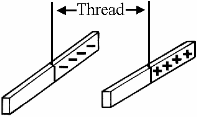 it is positively charged)*.
it is positively charged)*.
Opposite charges attract; similar charges repel each other.
You can demonstrate this by hanging two oppositely charged rods as shown and note that they both move towards each other.
The symbol for charge is Q.
The unit of charge is the Coulomb – symbol is C.
The Gold Leaf Electroscope
You must know the structure of an Electroscope and list some of its functions.
If the GLE is uncharged, the leaves will fall together.
If the leaves become charged – either positively or negatively – the leaves will stand apart (why?).
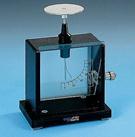
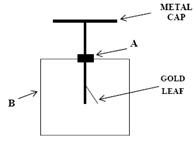 A = insulated joint, B = metal case
A = insulated joint, B = metal case
Functions:
- To detect charge
- To distinguish between positive and negative charge
- To indicate approximate size of a charge
- To test if an object is a conductor or an insulator
How would you use an electroscope to demonstrate each of these?
Earthing
If an object becomes charged (due to a build-up of electrons say), and the object is then ‘earthed’ (connected to earth), the electrons will separate as much as possible, resulting in most of them quite literally ‘going to earth’.
The object then becomes neutral.
Charging a conducting object by Induction
To Charge an Insulated Conductor Positively
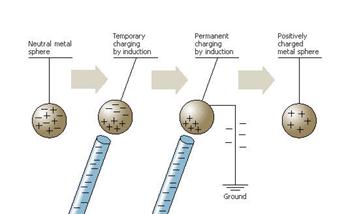
- Bring a negatively charge object near the conductor; the positive and negative charges become separated on it.
- Keeping the charged object in place, earth the conductor by touching it with your finger.
- Some of the negative charge on the metal flows through you to earth.
- Remove your finger, then and only then remove the rod.
- The conductor will now be positively charged.
You should now be able to draw the relevant diagrams to show how to charge an object negatively by induction.
Coulomb’s Law*
Coulomb’s Law states that the force between two point charges is proportional to the product of the charges and inversely proportional to the square of the distance between them.
Mathematically: F µ (Q1 Q2),
And F µ 1 / d2
F = ![]()
![]()
Putting this together where the proportional constant is
e (epsilon) is known as “the permittivity” of the medium; it represents the extent to which one charge will be affected by another, e.g. glass has a different permittivity value than air.
Note that eair (the permittivity of air) is taken to have the same value as e0 (the permittivity of a vacuum or free space).
(e0 = 8.9 × 10-12 F m-1)
Look at Problems 2 – 4, page 228. Then try Questions 3 – 8, page 229.
Electric Fields
An electric field is a region of space where electric forces can be felt.
Electric field lines: The convention is that lines come out of positive charges and go into negative charges.
Electric field strength (E) at a point is the force per unit charge at that point*
(This is possibly the most asked definition on the syllabus.)
![]()
The unit of Electric Field Strength is the Newton per Coulomb (NC-1).
E =![]()
![]()
Also note that because F =
See Problems 5 – 8, page 232. Then try Questions 1 – 4, and no.8, page 233.
To Demonstrate Electric Field Patterns*
- Place two electrodes in a petri-dish.
- Pour some oil into the petri-dish and sprinkle on some semolina powder.
- Connect a high voltage source (about 2,000 Volts) to the metal electrodes.
- Result: The semolina lines up in the direction of the field, showing the electric field.
NB: You will lose marks in an exam if you do not stress the high voltage.
Distribution of Charge on an Insulated Conductor*
- All static charge resides on the outside of a conductor.
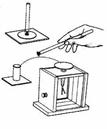 Demonstration
Demonstration
- Charge the conductor (a metal can will do fine).
- Using a proof plane, touch the inside of the can and bring it up to the GLE.
- Notice that there is no deflection.
- Touch the proof plane off the outside of the can and bring it up to the GLE.
- Notice that there is a deflection.
- Conclusion: charge resides on outside only
Application:
A Van de Graff Generator is used to generate a large build-up of charge which resides on the outside surface of the dome.
- Static Charge on a conductor tends to accumulate where the conductor is most pointed*.



Demonstration
- Charge a pear-shaped conductor .
- Use a proof plane to bring charge from the curved end to the GLE, and note that there is a minimal deflection.
- Use a proof plane to bring charge from the pointed end to the GLE, and note that the deflection is much greater.
- Conclusion: Most of the charge is at the pointed end.
Point Discharge (also known as ‘The Point Effect’)
We have seen that on a pear-shaped conductor, most charge accumulates on the pointed end (or at least it should!).
Now let’s assume the object is charged negatively.
If the build-up of charge at the pointed end is sufficiently large, it can attract nearby positive ions from the air and cause them to accelerate towards the pointed end.
En route, these ions are likely to crash off other molecules, causing them to become ionised (by knocking electrons off the atoms).
Ions with opposite charge to that on the point move towards this end and neutralise the charge on it.
Ions with the same charge move away from this end creating an ‘electric wind’.
Everyday Effects of Static Electricity
- Dust on Television Screens
- Static on Clothes
Applications of Electric fields
- Precipitators (Used to extract smoke particles from the air.
- Xerography (Photocopier machines)
Industrial Hazards
- Explosion in flour-mills
- Explosion when fuelling aircraft
- Damage to integrated circuits.
- Electric shock
You are also expected to know a little about lightning and lightning conductors.*
Leaving Cert Physics Syllabus
Content |
Depth of Treatment |
Activities |
STS |
|
|
|
|
CHARGES |
|
|
|
1. Electrification by |
Charging by rubbing together dissimilar materials. |
Demonstration of forces between charges. |
Domestic applications: Industrial hazards: |
|
|
|
|
2. Electrification by |
|
Demonstration using an insulated conductor and a nearby charged object. |
|
|
|
|
|
3. Distribution of |
Total charge resides on outside of a metal object. |
Van de Graaff generator can be used to demonstrate these phenomena. |
Lightning. |
|
|
|
|
4. Electroscope |
Structure. |
|
Uses. |
ELECTRIC FIELD |
|
|
|
1. Force between |
Coulomb’s law |
Appropriate calculations. |
|
|
|
|
. |
2. Electric fields |
Idea of lines of force. |
Demonstration of field patterns using oil and semolina or other method. |
Precipitators. |
Extra Credit
*If an object has more electrons than protons . . .
Just to complicate things, when scientists were first getting to grips with this stuff, they envisioned that there were two types of charge – positive and negative – and that they could both move.
It was actually American scientist/politician Benjamin Franklin who proposed the positive and negative charges theory. We now know of course that in actual fact it is only the negative charges (electrons) which can move along a material – the positive charges (protons) are stuck in the nuclei of the atoms and most definitely do not move.
As it so happens, all the phenomena we study in this chapter can be explained in terms of both types of charge moving, or just in terms of only electrons moving.
For some reason I still can’t fathom, we explain static electricity phenomena in terms of both charges moving.
As an exercise for yourself you could try to explain each concept in terms of only electrons moving.
Remember that if an object is neutral or uncharged, it does not mean that the object has no charge; merely that it has an equal amount of positive and negative charge, and they cancel each other out.
*Coulomb’s Law
The direction of the force is an attractive force if they are opposite charges, and a repulsive force if they are similar charges.
‘Permittivity’ is actually an unfortunate term – it should be called ‘unpermittivity’ or something more helpful, because the higher the value of e, the less will be the force between the two charges.
*An Electric Field is a region is space where an electric charge at rest experiences a force other than the force of gravity.
Not strictly true; a proton at rest could experience a ‘strong’ nuclear force, but we will conveniently ignore that for now.
An Electric Field Line is a line drawn in an electric field showing the direction of the force on a positive charge if placed in the field.
It’s easy to forget, but don’t leave out the part in italics
A simpler way of saying this is to say that the lines come out of positive charges and go into negative charges.
Note that where the electric field is strong, the field lines are close together; where the field is weak the lines are far apart.
* Electric Field Strength’
Why have a concept called ‘Electric Field Strength’?
Because we may need to know what effect a given charge would have on another charge, if that second charge was placed a certain distance from it.
But you can’t say that the first charge would produce a force of say 10 Newtons. Why not?
Because the size of the force depends on the magnitude of the two charges.
So to get around this we need a nominal second charge, and it makes sense to nominate this second charge to be unit charge, i.e. one Coulomb.
This means that if we know the effect the first charge will have on a charge of one Coulomb, we can get a feel for how strong it is.
This is important when designing circuit boards for example.
So there.
*To Demonstrate Electric Field Patterns
I must admit I’m not too sure what’s going on here.
I’m guessing that the oil is made up of polar molecules, which means that one side of the molecule is positive and the other side negative.
The negative side then turns towards the positive electrode (metal plate), and will even try to move towards it if it can overcome the inertia of the fluid.
The semolina is just there for the ride, but acts to illustrate the motion of the oil underneath.
Alternatively it may be that the semolina moves and the oil remains still.
Don’t tell anyone, but after looking at the youtube video, it actually seems to be a little of both!
*Distribution of Charge on an Insulated Conductor
Just so you know in advance, I rarely get these demonstrations to work properly!
Weather plays a part, but then a more experienced colleague mentioned to me casually one day: “You’ll never move enough charge with one transfer; you will have to repeat 10 – 20 times to get any deflection on the electroscope!”
Like I’m supposed to be clever enough to work this out for myself!
*Static Charge on a conductor tends to accumulate where the conductor is most pointed.We are not given a full explanation of why charge resides on the outside, or why charge accumulates at the pointy end; we are just told that this is the way charge arranges itself in order for each individual charge to be as far away as possible from all other charges.
I think a full explanation would involve a whole lot of rather difficult maths (some of which was on the old syllabus, in use up to a few years ago) so I suppose we should consider ourselves lucky that we don’t need to know it.
Still, it would be nice if the text-books were to at least acknowledge this.
Here is how I usually explain it, but I reckon it may be highly simplified:
The two electrons that are circled (see diagram above) don’t feel the effect of each other because the body of the conductor gets in the way and shields them. This is why the charges congregate around the highly curved areas.
The fact that charge resides on the outside of a conductor – be it solid or hollow – has very serious implications for the electronics industry.
For instance ESB workers dealing with high voltage lines wear a suit of conducting material, which means that they can’t get a shock.
In fact the surface doesn’t even have to be solid; a wire mesh or a cage would also work. Michael Faraday himself used to stand inside a cage which had a potential of a few thousand volts connected up to it, and he was quite safe.
He used to do this in public lectures, and this arrangement is now referred to as a ‘Faraday Cage’.
Along with no charge residing inside a conductor, neither is there any Electric Field. There is therefore no electrical interference to any electrical signal passing along a cable which is inside this wire mesh.
This is the principle behind a ‘co-ax’ (co-axial) cable, used to cover the television line which comes into the back of your TV set.
See the ‘Lineman’ video on youtube. Awesome.
*Lightning and lightning conductors
The temperature of the ionised gas in a lightning strike is typically 30,000 deg C, or five times hotter than the surface of the sun.
The current is typically 250,000A, but it only lasts for a few millionths of a second. Thus the average bolt of lightning could only provide the daily energy demand for perhaps 3 UK homes.
Worldwide though there are about 4 million flashes each day.
It was the American scientist/politician Benjamin Franklin who first established that lightning seemed to obey the same laws as electricity which was so intriguing to the scientists at the time.
He did this by attracting lighting from the sky by flying a kite during a thunderstorm. He was lucky not to have killed himself.
He also realised the significance of pointed conductors, and as a result invented the lighting conductor.
Because of the animosity which existed between America and Britain at this time, the British King (King George III) insisted that the lightning conductors at his palace should have round knobs on top.
The then president of the Royal Society resigned in protest at such idiocy.
These lightning conductors also attracted controversy when they were attached to the steeples of churches.
Many people believed that (i) they actually attracted lightning, and (ii) that the conductors were attempting to obstruct the will of God.
“Benjamin Franklin’s lightning conductor is a sacrilege that tries to avert the wrath of God. The destruction of Lisbon by the earthquake and tidal wave is God’s punishment of Man for the sacrilege”.
From a sermon by a Boston Minister (1753).
Ions can also affect how we feel.
Positive ions tend to induce a feeling of lethargy and irritability in the 30 per cent of the population who find themselves susceptible, and may induce nausea and headaches.
Air laden with positive ions occur during a thunderstorm, and also in the vicinity of fire.
Negative ions, on the other hand, have quite the opposite effect and induce a sense of physical and mental well-being. There is normally a high concentration of negative ions near the seashore, and in the rarefied air at the summits of very high mountains.
Negative ions are also created in the domestic shower and this is said to be why a shower produces a feeling of freshness and invigoration superior to the traditional bath.
Taken from an article by the late Brendan McWilliams in The Irish Times.
Did you know?
On a normal day, a cubic centimetre of air contains 1,200 positive ions and 1,000 negative ions.
These negative ions are generally oxygen with an extra electron, and the positive ones are carbon dioxide minus an electron.
Do you care?
Exam questions
(permittivity of free space = 8.9 × 10-12 Fm-1; charge on the electron = 1.6 × 10-19 C)
- [2008 OL]
Give one effect of static electricity?
- [2004]
Identify two hazards caused by static electricity.
- [2003 OL]
The build-up of electric charge can lead to explosions. Give two examples where this could happen.
- [2003 OL]
How can the build-up of electric charge on an object be reduced?
- [2010 OL]
How would you detect the presence of an electric field?

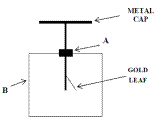 [2009 OL]
[2009 OL]
Name the instrument shown in the diagram.
- [2005 OL]
The diagram shows a gold leaf electroscope.
Name the parts labelled A and B.
- [2005 OL]
- Explain why the gold leaf on the electroscope diverges when a positively charged rod is brought close to the metal cap.
- The positively charged rod is held close to the electroscope and the metal cap is then earthed.
Explain why the gold leaf collapses.
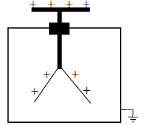 [2007 OL]
[2007 OL]- The diagram shows a positively charged gold leaf electroscope.
Describe how an electroscope is given a positive charge.
- What is observed when the cap of an electroscope is earthed?
- Why does this happen?
- How is the cap of the electroscope earthed?
- [2008]
Describe how an electroscope can be charged by induction
- [2003 OL]
Describe, with the aid of a labelled diagram, how you would charge a conductor by induction.
- [2005 OL]
Give one use of an electroscope.
- [2010 OL][2003 OL]
What is the unit of electric charge?
- [2005][2003][2007 OL][2010 OL]
State Coulomb’s law of force between electric charges.
- [2006][2005]
Why is Coulomb’s law an example of an inverse square law?
- [2005]
Give two differences between the gravitational force and the electrostatic force between two electrons.
- [2010][2009][2007][2005][2003][2002]
Define electric field strength.
- [2007][2003][2010]
Give the unit of electric field strength
- [2003]
![]() The diagram shows a negative charge – Q at a point X.
The diagram shows a negative charge – Q at a point X.
Copy the diagram and show on it the direction of the electric field strength at Y.
- [2007][2005][2003]
Describe an experiment to show an electric field pattern.
- [2008]
What is the force exerted on an electron when it is in an electric field of strength 5 N C–1?
- [2010]

- Copy the diagram into your answer-book and show on it the direction of the electric field at point P.
- Calculate the electric field strength at P.

- [2005]
- Calculate the electric field strength at the point B, which is 10 mm from an electron.
- What is the direction of the electric field strength at B?
- A charge of 5 μC is placed at B. Calculate the electrostatic force exerted on this charge.
- [2007]
- The dome of a Van de Graff generator is charged. The dome has a diameter of 30 cm and its charge is 4 C.
A 5 μC point charge is placed 7 cm from the surface of the dome.
Calculate the electric field strength at a point 7 cm from the dome.
- Calculate the electrostatic force exerted on the 5 μC point charge.

- [2005][2002 OL]
A pear-shaped conductor is placed on an insulated stand as shown. Copy the diagram and show how the charge is distributed over the conductor when it is positively charged.
- [2007]
All the charge resides on the surface of a Van de Graff generator’s dome. Explain why.
- [2007]
Describe an experiment to demonstrate that total charge resides on the outside of a conductor.
- [2007]Give an application of the fact that all charge resides on the outside of a conductor.
- [2010]
Under what circumstances will point discharge occur?
- [2010 OL]
- How does the lightning conductor prevent damage to the building?
Provides (safe) path for flow of current if struck // it earths the building //allows easy path for discharge etc.
- Suggest a suitable material for a lightning conductor.
Metal e.g. copper.
- [2002]
Read the following passage and answer the accompanying questions.
Benjamin Franklin designed the lightning conductor. This is a thick copper strip running up the outside of a tall building. The upper end of the strip terminates in one or more sharp spikes above the highest point of the building. The lower end is connected to a metal plate buried in moist earth. The lightning conductor protects a building from being damaged by lightning in a number of ways.
During a thunderstorm, the value of the electric field strength in the air can be very high near a pointed lightning conductor. If the value is high enough, ions, which are drawn towards the conductor, will receive such large accelerations that, by collision with air molecules, they will produce vast additional numbers of ions. Therefore the air is made much more conducting and this facilitates a flow of current between the air and the ground. Thus, charged clouds become neutralised and lightning strikes are prevented. Alternatively, in the event of the cloud suddenly discharging, the lightning strike will be conducted through the copper strip, thus protecting the building from possible catastrophic consequences.
Raised umbrellas and golf clubs are not to be recommended during thunderstorms for obvious reasons.
On high voltage electrical equipment, pointed or roughly-cut surfaces should be avoided.
(Adapted from “Physics – a teacher’s handbook”, Dept. of Education and Science.)
- Why is a lightning conductor made of copper?
- Why do the ions near the lightning conductor accelerate?
- How does the presence of ions in the air cause the air to be more conducting?
- How do the charged clouds become neutralised?
- What are the two ways in which a lightning conductor prevents a building from being damaged by lightning?
- Why are raised umbrellas and golf clubs not recommended during thunderstorms?
- Explain why pointed surfaces should be avoided when using high voltage electrical equipment.
Exam solutions
- Lightning, static discharge, receive shock after walking across carpets, attracts objects, can damage electronics.
- Electric shock / explosion in flour mills /explosion when fuelling aircraft/ damage to electronic devices / electrical storm / static cling, etc.
- Dust e.g. flour mill explosions, inflammable vapours e.g. fuelling aircraft, lightning
- By earthing the object (i.e. using a conductor to connect the object to the earth which allows the charge to flow to earth).
- Using an electroscope // electric field sensor // electric field meter
- A gold leaf electroscope
- A = insulation, B = metal/glass/plastic case
- Some of the electrons at the bottom of the electroscope are attracted to the top due to the positive charge on the rod and as a result there is an excess of positive charge on the bottom, including on the gold leaf. Because similar charges repel the gold leaf moves away from the main section.
- Some of the positive charges are repelled by the rod and so flow to the ground.
- Bring a negatively charged rod close to the cap.
Earth the electroscope by touching it with your finger while still holding the rod close by.
Remove your finger, then remove the rod.
- The leaves drop.
- The positive charges move from the cap to the earth (or the negative charges move from the earth to the cap).
- By touching it with your finger.
- See previous question.
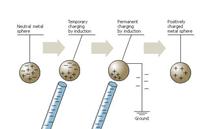 Apparatus e.g. conductor (hanging from insulated thread or mounted on an insulating stand) and a charged rod.
Apparatus e.g. conductor (hanging from insulated thread or mounted on an insulating stand) and a charged rod.
Bring a charged rod close to the conductor.
Earth the conductor by touching it with your finger while still holding the rod close by.
Remove your finger, then remove the rod.
- To detect charge
- The coulomb
- The force between two charges is proportional to the product of the charges and inversely proportional to the square of the distance between them.
- Force is inversely proportional to distance squared.
- Gravitational force is much smaller than the electrostatic force.
Gravitational force is attractive, electrostatic force (between two electrons) is repulsive.
- Electric field strength is defined as force per unit charge at that point.
- The unit of electric field strength is the newton per coulomb (N C-1).
- Arrow towards X
- High voltage and two metal plates /electrodes
Semolina and oil in container
Connect a (high) voltage to the plates in container
Semolina lines up in the field
- F = Eq Þ F = 5(1.6 × 10–19) Þ F = 8.0 × 10–19 N
 See diagram
See diagram- (For electric fields the convention is to assume the point to be a unit positive charge, so the point would be repelled from the positive and attracted towards the negative).
- The electric field strength at P is the sum of the electric fields acting on P from the other two charges. The electric field strength is towards the left in both cases (attracted to the negative charge and repelled from the positive charge). Because they are both in the same direction the individual field strengths can simply be added together.
![]()
![]()
Etotal = 3.77 × 106 N C-1
- E = Q/4πεd2
= (1.6 × 10-19)/4π(8.9 × 10-12)(0.01)2
E = 1.4 × 10-5 N C-1
- Towards the electron / to the right.
- F = Eq or F = (1.4 × 10-5)(5 × 10-6)
= 7.2 × 10-11 N
Towards the electron

Answer: E = 7.39 x 1011 N C-1
 F = E q
F = E q
F = (7.39 × 1011)(5 × 10-6) or F = 3.69 × 106 N
- See diagram. Charges are more concentrated at the pointed end.
- Like charges repel and the charges are a maximum distance apart on the outside surface of dome.
- Apparatus: metal can, gold leaf electroscope, proof plane.
Procedure: charge metal can and use proof plane to test inside and outside.
Observation: leaves on g.l.e. deflect for outside sample only.
Conclusion: charge resides on outside only .
- Electrostatic shielding / co-axial cable / TV (signal) cable / to protect persons or equipment, enclose them in hollow conductors /Faraday cages (there is no electric field inside a closed conductor), etc.
- It there is a very large electric field strength / If the potential at the point is very high / If there is a very high charge density at the point.
- Provides (safe) path for flow of current if struck // it earths the building //allows easy path for discharge etc.
- Metal e.g. copper.
- It is a good conductor.
- They experience a large electrostatic force of either attraction or repulsion.
- The ions act as charge carriers.
- Electrons flow to or from the ground through the air.
- Neutralises charged clouds
It conducts charges to earth.
- Because they act as lightning conductors.
- Sparking is more likely to occur from these points due to point discharge.
Source : http://www.thephysicsteacher.ie/LC%20Physics/Student%20Notes/19.%20Static%20Electricity.doc
Web site link: http://www.thephysicsteacher.ie
Author : not indicated on the source document of the above text
Static electricity
Static electricity
Static electricity
This is the right place where find the answers to your questions like :
Who ? What ? When ? Where ? Why ? Which ? How ? What does Static electricity mean ? Which is the meaning of Static electricity?
Static electricity physics notes
Alanpedia.com from 1998 year by year new sites and innovations
Main page - Disclaimer - Contact us